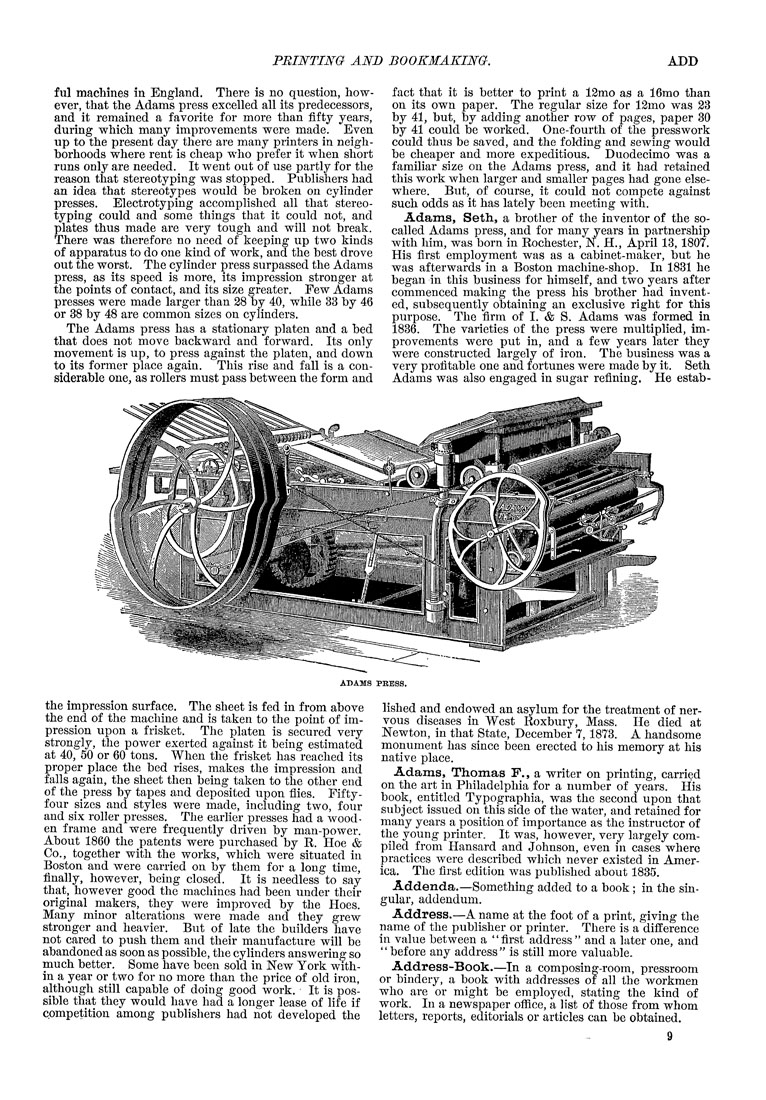PRINTING AND BOOKMAKING.
ADD
ful machines in England. There is no question, how¬
ever, that the Adams press excelled all its predecessors,
and it remained a favorite for more than fifty years,
during which many improvements were made. Even
up to the present day there are many printers in neigh¬
borhoods where rent is cheap who prefer it when short
runs only are needed. It went out of use partly for the
reason that stereotyping was stopped. Publishers had
an idea that stereotypes would be broken on cylinder
presses. Electrotyping accomplished all that stereo¬
typing could and some things that it could not, and
plates thus made are very tough and will not break.
There was therefore no need of keeping up two kinds
of apparatus to do one kind of work, and the best drove
out the worst. The cylinder press surpassed the Adams
press, as its speed is more, its impression stronger at
the points of contact, and its size greater. Few Adams
presses were made larger than 28 by 40, while 33 by 46
or 38 by 48 are common sizes on cylinders.
The Adams press has a stationary platen and a bed
that does not move backward and forward. Its only
movement is up, to press against the platen, and down
to its former place again. This rise and fall is a con¬
siderable one, as rollers must pass between the form and
fact that it is better to print a 12mo as a 16mo than
on its own paper. The regular size for 12mo was 23
by 41, but, by adding another row of pages, paper 30
by 41 could be worked. One-fourth of the presswork
could thus be saved, and the folding and sewing would
be cheaper and more expeditious. Duodecimo was a
familiar size on the Adams press, and it had retained
this work when larger and smaller pages had gone else¬
where. But, of course, it could not compete against
such odds as it has lately been meeting with.
Adams, Seth, a brother of the inventor of the so-
called Adams press, and for many years in partnership
with him, was born in Rochester, N. H., April 13, 1807.
His first employment was as a cabinet-maker, but he
was afterwards in a Boston machine-shop. In 1831 he
began in this business for himself, and two years after
commenced making the press his brother had invent¬
ed, subsequently obtaining an exclusive right for this
purpose. The firm of I. & S. Adams was formed in
1836. The varieties of the press were multiplied, im¬
provements were put in, and a few years later they
were constructed largely of iron. The business was a
very profitable one and fortunes were made by it. Seth
Adams was also engaged in sugar refining. He estab-
ADAMS PRESS.
the impression surface. The sheet is fed in from above
the end of the machine and is taken to the point of im¬
pression upon a frisket. The platen is secured very
strongly, the power exerted against it being estimated
at 40, 50 or 60 tons. When the frisket has reached its
proper place the bed rises, makes the impression and
falls again, the sheet then being taken to the other end
of the press by tapes and deposited upon flies. Fifty-
four sizes and styles were made, including two, four
and six roller presses. The earlier presses had a wood¬
en frame and were frequently driven by man-power.
About 1860 the patents were purchased by R. Hoe &
Co., together with the works, which were situated in
Boston and were carried on by them for a long time,
finally, however, being closed. It is needless to say
that, however good the machines had been under their
original makers, they were improved by the Hoes.
Many minor alterations were made and they grew
stronger and heavier. But of late the builders have
not cared to push them and their manufacture will be
abandoned as soon as possible, the cylinders answering so
much better. Some have been sold in New York with¬
in a year or two for no more than the price of old iron,
although still capable of doing good work. It is pos¬
sible that they would have had a longer lease of life if
competition among publishers had not developed the
lished and endowed an asylum for the treatment of ner¬
vous diseases in West Roxbury, Mass. He died at
Newton, in that State, December 7, 1873. A handsome
monument has since been erected to his memory at his
native place.
Adams, Thomas F., a writer on printing, carried
on the art in Philadelphia for a number of years. His
book, entitled Typographia, was the second upon that
subject issued on this side of the water, and retained for
many years a position of importance as the instructor of
the young printer. It was, however, very largely com¬
piled from Hansard and Johnson, even in cases where
practices were described which never existed in Amer¬
ica. The first edition was published about 1835.
Addenda.—Something added to a book ; in the sin¬
gular, addendum.
Address.—A name at the foot of a print, giving the
name of the publisher or printer. There is a difference
in value between a "first address" and a later one, and
"before any address" is still more valuable.
Address-Book.—In a composing-room, pressroom
or bindery, a book with addresses of all the workmen
who are or might be employed, stating the kind of
work. In a newspaper office, a list of those from whom
letters, reports, editorials or articles can be obtained.
|








